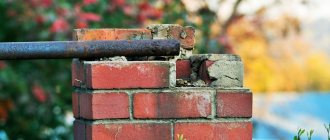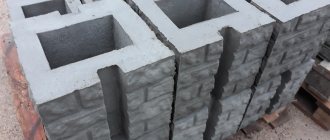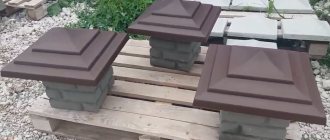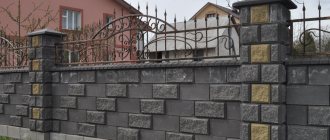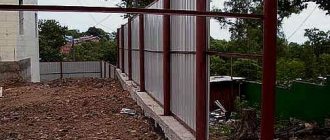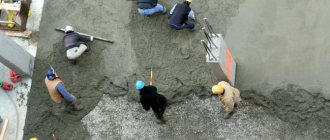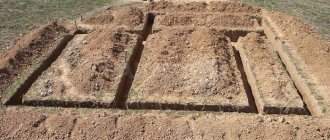Making reinforced concrete fence posts with your own hands
Thrifty owners buy only what they cannot do without - if something can be done on their own, they do it: reinforced concrete structures, including steps, floors, slabs and pillars.
In this article we will tell you how to make a reinforced concrete fence post, which will be no different from industrial analogues, except for its cost.
Main Dimensions
The length of factory posts ranges from 1.7 to 4.2 m, which allows you to select the height of the supports taking into account the purpose of the fence. The minimum cross-section is from 13*13 cm and above.
Photo: size guide and various shapes of reinforced concrete pillars from the manufacturer
Kawabang!
What types of concrete pipes are there, why and where they are used? If the list of products does not contain sizes suitable for you, you can place an individual order.
Manufacturing of reinforced concrete pillar
Industrial concrete pillar is good, but a little expensive
The formation of concrete supports for a fence on site is well known to many - the foundation is prepared, formwork is constructed, reinforcement is tied in and everything is poured with concrete. The result is a high-quality product, but it takes too long to do all this - it’s more convenient to use ready-made poles.
Step No. 1 - casting matrix
In order to fill the pillar, you need to make a mold for this - we will use a PVC pipe for external sewerage. The sizes are suitable. For thin poles, a PVC pipe with a diameter of 100 mm is suitable; for more massive ones there are 200, 250 and 300 mm. When choosing, you need to take into account your strength - concrete pillars weigh a lot.
Making reusable formwork for a pole
To ensure the reliability of the formwork (pipe), several through holes can be made.
Step No. 2 - knitting reinforcement
Without reinforcement, a concrete pillar will not last long. For reinforcement we will use welded mesh with a wire thickness of 3-4 mm.
When working with welded mesh, we use a grinder, a sledgehammer and other metalworking tools.
Step No. 3 – installation of formwork (PVC pipes)
We assemble the formwork. To do this, we place an armored belt in one half of the pipe and close the other half of the PVC pipe on top. We fix the formwork to a bolted rod.
The sewer pipe has a connecting connector on one side - a larger diameter coupling. Inside it there is a groove for an o-ring - we will use it to place the damper in it.
The clamp can be made from perforated tape and a bolt with a nut.
Clamps must also be placed on the other end of the pipe and its middle.
Installing the bottom in the formwork and fixing it with homemade clamps
On the bottom cover you can form additional elements, as in Fig. 5 - they are needed to form fastening holes for the fence crossbars (so as not to drill the post later).
Step No. 4 - concreting the pillar
Concreting can be done with either ordinary cement mortar or concrete. You can also add some additives to the solutions. Liquid glass will increase the waterproofing property of concrete, and liquid soap will make the solution more plastic, which will make it possible to obtain products with smoother surfaces.
For cement mortar we will use Portland cement M 200 - in the ratio of 1 part cement, 3 parts sand and 3 liters of water. Sand should be used in coarse grain sizes.
When mixing, add liquid glass about 100 ml per 15 liters. bucket of solution. Add 1-2 bottle caps of liquid soap.
Preparation of cement mortar
After mixing the components, the solution is ready.
Step No. 5 – filling the PVC mold
We fix the pipe vertically. Pour the cement mixture inside the plastic formwork. We use a pole to tamp and remove bubble air. Leave the product to dry. After a day, the formwork can be removed.
How concrete posts are made and installed
Various methods are used to manufacture products:
The manufacturing technology does not depend on the method and consists of the following stages:
- formwork assembly;
- installation of power grid;
- preparing the solution;
- pouring concrete mortar into molds.
Installation of prefabricated supports is carried out in the following sequence:
Site preparation and marking for installation of concrete fence posts
The preparatory stage includes the following work:
- cleaning the surface from large stones;
- removal of bushes and small plants;
- leveling the soil surface.
For marking you need:
- drive pegs into the soil along the edges;
- pull the cord between them;
- drive in the remaining pegs at the required pitch (along the cord).
Preparing the base for concrete pillars
- level the bottom of the pit;
- pour a mixture of crushed stone and sand onto the bottom;
- level the surface;
- compact thoroughly by pouring water.
How to choose the location of the formwork and install the load-bearing frame
Before assembling the formwork, it is necessary to cut out the blanks.
Features of the formwork location:
- it is installed vertically if the supports are poured at the site of the upcoming installation (spacers are used for fixation);
- The formwork is placed in a horizontal position if the pillars are pre-concreted.
To create a frame you need:
- 4 rods with a diameter of 1.2-1.8 cm, located in parallel;
- transverse rods with a diameter of 0.8-1 cm, fixed at intervals of 10-15 cm.
It is installed so that there is a gap (20-25 mm) from the reinforcement grid to the concrete.
How fence posts are poured with concrete mortar
When pouring racks, perform the following operations:
- lubricate the inside of the formwork;
- they place a grid of reinforcement in the formwork;
- Fill the form with concrete mortar and compact it.
When hydration is complete, the finished support is removed and left to dry.
How to decorate finished concrete supports
Any type of finishing can be used for a concrete base.
A common option is plaster; when decorating concrete pillars, several types are used:
To decorate concrete surfaces, paint compositions (polyurethane, rubber, acrylic, epoxy) are used. In addition to decoration, they create a protective layer.
Each of the colors has its own characteristics:
The polyurethane composition has good characteristics, but it takes a long time to dry (about 14 days). A popular type of finishing remains cladding (mosaic or brick is used). During the installation process, various techniques are used and drawings are laid out.
Kawabanga! Rules for laying floor slabs on a structure
Main stages of manufacturing
Regardless of the specifics of the manufacturing technology, the set of measures according to which concrete pillars are made includes the following steps:
It is worth remembering that the service life directly depends on the quality of the material used in the manufacture of supports
Alternative manufacturing methods allow you to pour a concrete pillar with your own hands directly on the site where it will be used in the enclosing structure. Let us dwell in detail on the features of the stages of work.
Manufacturing of formwork
High-quality formwork allows you to ensure the presentation of products and guarantee their strength characteristics, provided that the appropriate cement mortar is used and the correct reinforcement is used. When thinking about formwork for fences and posts, pay attention to the following points:
Concrete supports have only one drawback - the need to create a foundation for their installation, without which the fence can bend and collapse
The design features of the formwork should allow easy removal of the finished product. This is ensured by the trapezoidal cross-section of the structure, poured on a separate site and the use of planed boards. To make it easier to remove concrete fence posts, use plastic film placed before pouring the concrete mass.
Forms made of wood and metal can be used repeatedly, are quickly assembled and easily dismantled. They allow you to reproduce the required geometry of the supporting elements of the fence.
When making formwork designed to form permanently installed fence posts, pay attention to the strength of the section located at the bottom of the column and supporting the weight of the concrete mass.
Circular support elements, poured on site, can be formed in disposable cardboard forms, reinforced on the outside with a wooden frame or steel mesh for reinforcement.
The formwork, poured with concrete at the installation site, takes up increased loads in the lower part and is distinguished by a vertical position when pouring. A vertically located, unstable structure requires the installation of reliable supports. When ensuring that a vertically positioned structure is stationary, avoid bending it, as it is susceptible to bending loads.
Having made concrete fence posts with your own hands once, you can do it at any time as needed
The main condition is high-quality formwork
It is no secret that concrete fence posts are strong and even only when good formwork is made for casting them. Therefore, you should not save on this design. The more carefully you make it, the more pillars will come out of it.
The simplest formwork option is a wooden box-shaped structure . Three sides and ends are made of planed boards, and the fourth is left open for pouring concrete mixture.
To prevent cement milk from leaking out of the formwork, the boards should be carefully adjusted, or even better, lay plastic film, oilcloth inside the formwork, or line its walls with plastic. Such protection will protect the formwork from deformation and swelling. Concrete and smooth walls that do not absorb water come off very easily, so there will be no problems with dismantling such formwork.
It is better to assemble a structure from boards using screws, since, unlike nails, they can be easily removed without damaging the boards.
Related article: DIY cradle for newborns: description of the design
Variant of forms for concrete fences
Reinforcement
Concrete columns for the enclosing structure will be strong if you take a responsible approach to the manufacture of the reinforcement frame. Concrete pillars absorb compressive loads and bending forces. That is why a frame made of steel reinforcement is needed.
Structurally, it represents a spatial system, the basis of which is the following elements:
When installing the reinforcement cage, ensure a fixed distance of 2-2.5 cm from the steel bars to the walls. This will protect the reinforcement elements from the destructive effects of corrosion.
Preparation of concrete solution
Preparing concrete composition for pillars is a critical operation performed after installing the reinforcement cage. The quality of the mixture and increased strength characteristics of concrete products will be ensured by the following components:
To make the pillars as strong as possible, use only high-quality cement
The optimal ratio of crushed stone, sand and cement is 2:2:1. When preparing concrete, mix the ingredients using a concrete mixer. This will ensure a uniform consistency of the mixture. Having prepared the solution, you can start pouring.
Preparing concrete for pillars
After the formwork has been assembled and the frame has been installed, the concrete mixture should be properly prepared. The filler for it should not be too large, since the transverse size of the pillars is small. Therefore, buy small crushed stone with a fraction of 5-10 mm.
After mixing the concrete mixture (preferably in a concrete mixer, not by hand), you can begin pouring the form. Remember that it is not enough to simply fill the pillar with concrete, since this creates many air pockets in it, which reduce the strength.
Therefore, after filling, be sure to vibrate the formwork . As the concrete mixture settles, it will become much denser and will displace air. For this operation, you can use a conventional hammer drill, in which a reinforcing bar with a thrust pad welded to it is installed. By placing a hammer drill on different areas of the wooden formwork, you will quickly and efficiently compact the concrete mixture.
Related article: Why does an LED lamp glow after being turned off?
If you don’t have a hammer drill, be sure to “prick” the poured concrete with a short piece of reinforcement.
Features of alternative manufacturing technology
In a number of situations, it is advisable to manufacture supporting elements for the enclosing structure at the installation sites along the perimeter of the future fence. For these purposes, builders use sliding formwork, the elements of which are parts of a steel pipe cut along the longitudinal axis, with a diameter of about 1 meter. The components of the form are equipped with brackets with holes that allow you to fix the structural elements. Carry out the process of pouring support elements for the fence with your own hands according to the following algorithm:
High-quality formwork is the key to creating smooth and strong concrete pillars
Developers also use PVC pipes of increased diameter and asbestos cement formwork as a form for the construction of support posts. The technology makes it possible to cast supports of round, square, rectangular and rhombic cross-sections.
Making pillars
First you need to prepare all the necessary materials and tools. Robots for making concrete fence posts with your own hands are carried out in several stages, each of which requires detailed consideration.
Creating formwork
It is high-quality formwork that guarantees smooth and reliable supports. The simplest type of formwork is a box of the required dimensions, made of plywood. If this material is not available, then ordinary boards will do. Three sides of the box and its ends must be fastened together, and one side must remain free for pouring the solution.
Advantages and disadvantages of concrete fence posts
You can make concrete fence posts yourself.
Concrete is a durable, reliable and affordable material. You can buy ready-made concrete mix or make it yourself. In a semi-liquid form, the mass has the highest plasticity and, when solidified, takes on any shape.
Concrete supports have many advantages:
- high load-bearing load – fencing sections can consist of any material;
- the stone is resistant to rain, snow, wind and sun, which ensures the durability of the fence;
- concrete is not subject to corrosion and other damage;
- supports of any size and shape are cast from the material, this allows you to equip fences in a variety of styles;
- concrete is not afraid of temperature changes, so it is used in both southern and northern regions;
- the supports do not require special maintenance: they do not need to be painted, primed, or treated with impregnations;
- The cost of the material is extremely low.
Minuses:
- The main disadvantage is the heavy weight. You can make and install one pole with two people, but to install an entire section you will need the help of a team.
- The appearance of concrete is unattractive.
For fencing made of lightweight materials, only support posts are required. If the fence is being built heavy - stone, brick, for example, it is necessary to erect the fence on a foundation, with a basement section. This option is much stronger, but also more massive. It will take a lot more time and effort.
Round supports
To do this, you will need a piece of pipe about one meter long, which will act as formwork. It must first be cut into two parts with a grinder and “ears” with holes for bolts must be welded to each of them. They are necessary to connect two parts of the formwork. The reinforcement frame will be mounted in the pit where it is planned to install the support.
After this, the pit is filled with concrete to the level of the ground surface, and the support is made using the sliding formwork method. The pipe should be lubricated with machine oil to simplify the process of subsequent disassembly and installed on the ground. Having leveled its position in a vertical plane, all that remains is to pour the solution and leave for several days.
After the concrete has hardened, the bolts must be loosened slightly and the formwork must be moved up three-quarters, and then filled again with mortar. This process must be repeated until the support reaches the required height.
Source
